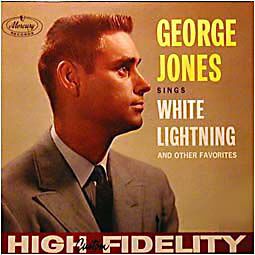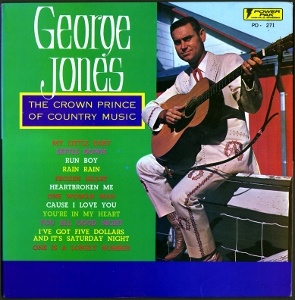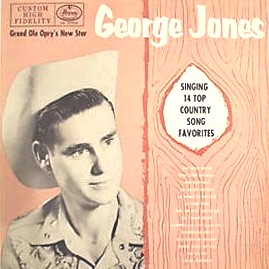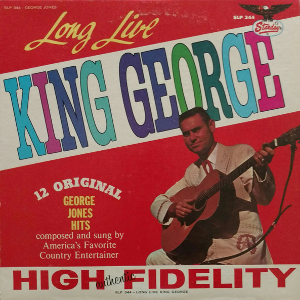
Starday Records was an American record label producing traditional country music during the 1950s and 1960s.

I Wish Tonight Would Never End is an album by American country music artist George Jones. It was released in 1963 on the United Artists record label.

George Jones Salutes Hank Williams is the 1960 country music studio album released in May 1960 by George Jones. The album was the ninth studio LP release, and was recorded in one session. The album has been reissued multiple times since its release, including the tracks being reused on many compilations.

White Lightning and Other Favorites is a studio album released by George Jones on May 26, 1959. Its title track "White Lightning" was a #1 Country hit in 1959.

Country Church Time is the sixth studio album released by George Jones on January 20, 1959. The LP includes multiple early gospel recordings by Jones on Starday.

Grand Ole Opry's New Star is the debut studio album released by George Jones in November 1956 with Starday Records. Produced by Jones' manager Pappy Daily, the album was recorded during early sessions in 1954, throughout 1955, and other sessions in 1956. It is also the first album to be released on the Starday label, a label only four years old.

The albums discography of American country artist, George Jones contains 80 studio albums, 132 compilation albums, three live albums, ten video albums and seven box sets. Of his studio albums, 69 are solo releases while 11 are collaborative releases. In 1956, Jones's debut studio LP was issued on Starday Records titled, Grand Ole Opry's New Star. The label only issued one studio effort, but would release a series of compilation. On Mercury Records, Jones released six studio LP's including Country Church Time (1959) and George Jones Salutes Hank Williams (1960). He switched to the United Artists label in 1962, where he released 13 studio LP's. Among these was a collaborative LP with Melba Montgomery called What's in Our Hearts (1963), which was his first to chart the Billboard Top Country Albums survey. He moved to Musicor in 1965. Among the label's studio LP's was I'm a People (1966), which reached the top of the Billboard country survey. Musicor also issued his first collaborative studio album with Gene Pitney, which made the Billboard country LP's chart and the Billboard 200.
Harold W. Daily, better known as "Pappy" Daily, was an American country music record producer and entrepreneur who cofounded the Texas-based record label Starday Records. Daily worked with many of the well-known artists in country music during the 1950s and 1960s, especially George Jones, who looked upon him as a father figure and as a business advisor. Other artists with whom Daily worked include Melba Montgomery, J. P. Richardson, and Roger Miller.

"Why Baby Why" is a country music song co-written and originally recorded by George Jones. Released in late 1955 on Starday Records and produced by Starday co-founder and Jones' manager Pappy Daily, it peaked at 4 on the Billboard country charts that year. It was Jones' first chart single, following several unsuccessful singles released during the prior year on Starday.
"White Lightning" is a song written by the rockabilly artist J. P. Richardson, best known by his stage name, the Big Bopper. The song was recorded by American country music artist George Jones and released as a single in February 1959. On April 13, 1959, Jones' version was the first number-one single of his career. The song has since been covered by numerous artists. Richardson never got to see the success of the record, as he had been killed in an airplane accident 6 days before its release.
De Armand Alexander "Eddie" Noack, Jr., was an American country and western singer, songwriter and music industry executive. He is best known for his 1968 recording of the controversial murder ballad, "Psycho", written by Leon Payne, produced by John Capps and issued on the K-ark Records label.

My Country is a double album by George Jones. It was released on the Musicor label in 1968.

The singles discography of American country artist, George Jones, contains 182 singles. Of the total, 136 were released with Jones as the solo artist. In addition, 31 were issued with Jones being part of a collaboration. Thirdly, eight singles were issued with Jones being part of a featured act. Fourthly, seven released were promotional singles. Additionally, 14 songs that are not released as singles are included that made any major chart. Finally, 21 music videos which were first issued as singles are also listed. Jones had his first chart success in 1955 with several top ten Billboard Hot Country Songs singles: "Why Baby Why", "What Am I Worth" and "You Gotta Be My Baby". After several more top ten releases, "White Lightning" became his first to top the Billboard country chart. Along with "Who Shot Sam", both singles were also his first to make the Hot 100 charts.
"Color of the Blues" is a 1958 country song written by George Jones and Lawton Williams and released by Jones on January 15, 1958.
"Seasons of My Heart" is a song written by George Jones and Darrell Edwards. The song was released as the b-side to the #4 hit "Why Baby Why" in 1955. The song was also recorded by Johnny Cash and, released in 1960, it became a #10 hit.
"Don't Stop the Music" is a song written and recorded by George Jones. It was his first single release on Mercury-Starday and peaked at #10 on the country singles chart in early 1957.
"Aching, Breaking Heart" is a song by George Jones. It was his last single on Mercury Records before moving to United Artists. The song peaked at number five on the Billboard country chart in March 1962. During his tenure with Starday and Mercury, Jones had amassed eleven top-ten hits, with "White Lightning" and "Tender Years" both topping the charts. However, Jones' producer and manager Pappy Daily had secured a more lucrative deal with UA. In the 1994 Mercury Jones retrospective, Cup of Loneliness: The Classic Mercury Years, Colin Escott notes, "Mercury lost George just as he was on the verge of ruling the charts. Art Talmadge had left Mercury Records and gone to United Artists and when George's Mercury contract expired at the end of 1961, Pappy took him to U.A. The first single, the classic "She Thinks I Still Care", was one of seven records George would chart in 1962."

The Crown Prince of Country Music is the 1960 country music compilation album released by Starday Records of previously unissued recordings released in January 1960. The album's original release, like the reissue edition, did not chart.

George Jones Sings is a compilation album released by George Jones in May 1957. The album didn't chart well; however, it plays many of his best early recordings.
The Fabulous Country Music Sound of George Jones is the 1962 country music compilation album released by George Jones in August 1962. the album compiled a series of previously-released tracks. It contains songs dated back to 1955 while with Starday, to his second #1 hit with Mercury in 1960.











